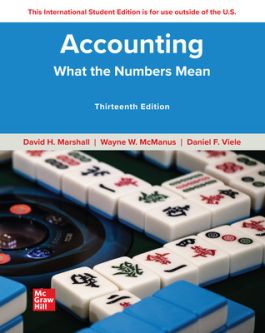Accounting: What the Numbers Mean ISE
13th Edition
1265580383
·
9781265580384
© 2023 | Published: January 18, 2022
Designed for non-majors, Accounting: What the Numbers Mean, guides students through the basics: what accounting information is, how it is developed, how it is used, and what it means. Financial statements are examined to learn what they do and do not…
Read More
After purchasing your eBook, login to the McGraw Hill Bookshelf website and redeem the access code from your order confirmation email.
- Access your eBook online or offline
- Easily highlight and take notes
- Fully searchable content
- Syncs across platforms
NOTE: eBook purchase does not include Connect homework or adaptive SmartBook assignments
Chapter 1: Accounting—Present and Past 2
Part 1: Financial Accounting
Chapter 2: Financial Statements and Accounting Concepts/Principles
Chapter 3: Fundamental Interpretations Made from Financial Statement Data
Chapter 4: The Bookkeeping Process and Transaction Analysis
Chapter 5: Accounting for and Presentation of Current Assets
Chapter 6: Accounting for and Presentation of Property, Plant, and Equipment, and Other Noncurrent Assets
Chapter 7: Accounting for and Presentation of Liabilities
Chapter 8: Accounting for and Presentation of Stockholders’ Equity
Chapter 9: The Income Statement and the Statement of Cash Flows
Chapter 10: Corporate Governance, Notes to the Financial Statements, and Other Disclosures
Chapter 11: Financial Statement Analysis
Part 2: Managerial Accounting
Chapter 12: Managerial Accounting and Cost–Volume–Profit Relationships
Chapter 13: Cost Accounting and Reporting
Chapter 14: Cost Planning
Chapter 15: Cost Control
Chapter 16: Costs for Decision Making
Epilogue: Accounting—The Future
Appendix: Campbell Soup Company 2020
Part 1: Financial Accounting
Chapter 2: Financial Statements and Accounting Concepts/Principles
Chapter 3: Fundamental Interpretations Made from Financial Statement Data
Chapter 4: The Bookkeeping Process and Transaction Analysis
Chapter 5: Accounting for and Presentation of Current Assets
Chapter 6: Accounting for and Presentation of Property, Plant, and Equipment, and Other Noncurrent Assets
Chapter 7: Accounting for and Presentation of Liabilities
Chapter 8: Accounting for and Presentation of Stockholders’ Equity
Chapter 9: The Income Statement and the Statement of Cash Flows
Chapter 10: Corporate Governance, Notes to the Financial Statements, and Other Disclosures
Chapter 11: Financial Statement Analysis
Part 2: Managerial Accounting
Chapter 12: Managerial Accounting and Cost–Volume–Profit Relationships
Chapter 13: Cost Accounting and Reporting
Chapter 14: Cost Planning
Chapter 15: Cost Control
Chapter 16: Costs for Decision Making
Epilogue: Accounting—The Future
Appendix: Campbell Soup Company 2020
Designed for non-majors, Accounting: What the Numbers Mean, guides students through the basics: what accounting information is, how it is developed, how it is used, and what it means. Financial statements are examined to learn what they do and do not communicate, enhancing the student’s decision-making and problem-solving abilities from a user perspective. This approach benefits a variety of non-accounting majors, including students focusing on other areas of business or nonbusiness programs such as engineering, behavioral sciences, public administration, or prelaw.?

